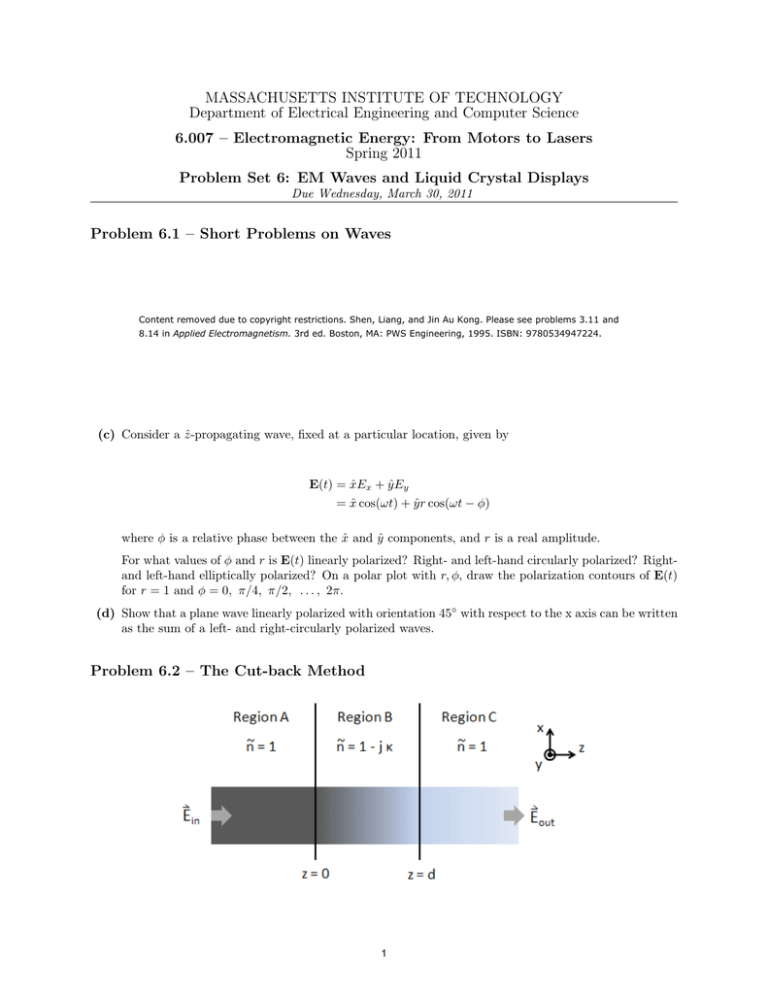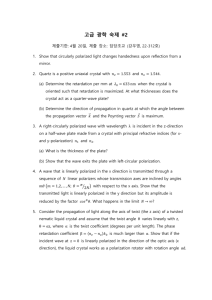Document 13440115
advertisement

MASSACHUSETTS INSTITUTE OF TECHNOLOGY Department of Electrical Engineering and Computer Science 6.007 – Electromagnetic Energy: From Motors to Lasers Spring 2011 Problem Set 6: EM Waves and Liquid Crystal Displays Due Wednesday, March 30, 2011 Problem 6.1 – Short Problems on Waves Content removed due to copyright restrictions. Shen, Liang, and Jin Au Kong. Please see problems 3.11 and 8.14 in Applied Electromagnetism3rd ed. Boston, MA: PWS Engineering, 1995. ISBN: 9780534947224. (c) Consider a ẑ-propagating wave, fixed at a particular location, given by E(t) = x̂Ex + ŷEy = x̂ cos(ωt) + ŷr cos(ωt − φ) where φ is a relative phase between the x̂ and ŷ components, and r is a real amplitude. For what values of φ and r is E(t) linearly polarized? Right- and left-hand circularly polarized? Rightand left-hand elliptically polarized? On a polar plot with r, φ, draw the polarization contours of E(t) for r = 1 and φ = 0, π/4, π/2, . . . , 2π. (d) Show that a plane wave linearly polarized with orientation 45◦ with respect to the x axis can be written as the sum of a left- and right-circularly polarized waves. Problem 6.2 – The Cut-back Method 1 6.007 Spring 2011 Problem Set 6: EM Waves and Liquid Crystal Displays (a) In her lab, Veronica has the three-region system pictured above. She shines collimated monochromatic light incident from Region A with the form Ein = x̂Eo ej(ωt−ko z) where ko = 2π λo Write the expression for Eout , the electric field of the output in Region 3, as well as the incident intensity Iin and the output intensity Iout . (b) Beer’s Law states that in an absorbing medium Iout = Iin e−αz What is α in terms of κ? (c) Veronica takes some measurements and discovers that Iin = 4 mW and Iout = 2 mW. She also measures d = 1 m. Calculate α and κ if λo = 500nm. Don’t forget to include the units of α and κ. (d) Veronica’s friend Victor tells her that he has the exact same three-region system, except that d = 2 m for him. He is also trying to measure α and κ. Victor took a measurement by using a collimated monochromatic light source that he owns, which is at the same wavelength as Veronica’s, and got that Iout = 4 mW. He does not know the incident intensity of his light source. He asks Veronica if he can borrow her three-region system that has d = 1 m for the weekend. Veronica has a serious crush and Victor, so she agrees. Victor takes a measurement using his light source and Veronica’s system and finds that Iout = 8 mW. Victor does not know the intensity of his light source, but he knows that it is the same wavelength as Veronica’s. Does he need to know the intensity of his light source to find α and κ? Show that Victor’s measurement is consistent with Veronica’s. Why do you think this method of determining α and κ is called the “cut-back method”? Problem 6.3 – Polarization and Birefringence http://www.olympusmicro.com/primer/lightandcolor/birefringence.html Birefringence in calcite is responsible for the double image of the pencil seen here. Image of calcite crystal from http://www.olympusmicro.com/primer/lightandcolor/birefringence.html. © Olympus America Inc. All rights reserved. This content is excluded from our Creative Commons license. For more information, see http://ocw.mit.edu/fairuse. 2 6.007 Spring 2011 Problem Set 6: EM Waves and Liquid Crystal Displays Calcite is a birefringent material, which means that different polarizations see different indices of refraction. We can model the birefringence as different molecular “spring constants” for different polarizations. Consider a plane wave propagating in the +ẑ direction. We can decompose this wave into an Ex and an Ey component. The Ex (z) wave will see an electron with spring constant Kx . The Ey (z) wave will see an electron with spring constant Ky . In calcite, Ky = Kz = Kx . x Electron cloud kx kz ky z y Image by MIT OpenCourseWare. Figure 1: Cartoon model for a birefringent material. The electron is localized between 3 pairs of atoms in a crystal. Atoms at z = ±d and y = ±d “pull harder” than the atomic pair at x = ±d. Note that Ky = Kz = Kx . (a) Refer to Fig. 1. Why can’t we create a waveplate where the wave propagates along x̂? (b) You have choosen the ẑ axis to be the propagation axis. Write the phasor expression for the E field of a 640 nm plane wave polarized at 45◦ . Do the same for a right circularly polarized plane wave. Write the associated H fields. Optical Properties of Calcite Crystal Index of Refraction no ne 1.65 1.6 1.55 1.5 1.45 0.5 1 1.5 Wavelength (microns) 2 Figure 2: Dispersion relation of calcite. Calcite is transparent over the given range (the imaginary part of n is zero). This curve could be found from the Lorentz oscillator model. (c) Fig.2 shows how ne (the index of refraction for extraordinary rays) and no (the index of refraction for ordinary rays ) vary across different wavelengths. At the free space wavelength of λo = 640 nm, ne = 1.485 and no = 1.656. What is the speed of each polarization component of the linear wave from Part (b)? What is the wavelength of each component inside the calcite? (d) How thick should the calcite slab be for a λ/4 plate at λo = 640 nm? 3 6.007 Spring 2011 Problem Set 6: EM Waves and Liquid Crystal Displays Problem 6.4 — Energy in the alignment of LCs In lab 3, we’ll be making a rudimentary liquid crystal display pixel using the nematic liquid crystal 5CB (4’­Pentyl­4­biphenylcarbonitrile), shown below in Fig.3. CH3(CH2)3CH2 n^ CN Image by MIT OpenCourseWare. Figure 3: Schematic of 5CB nematic liquid crystal molecule. The orientation of 5CB can be changed by taking advantage of the dielectric anisotropy of the medium. Macroscopically, we observe the the medium has a static (DC, ω = 0) dielectric constant of El = 19.7 when electric fields are oriented along the long axis (n̂ above, extraordinary polarization) of the liquid crystals in the medium. Additionally, we observe that the relative dielectric constant of the liquid crystal medium is E⊥ = 6.7 when electric fields are oriented perpendicular to n̂ (ordinary polarization). In constructing a liquid crystal display, the liquid crystal medium is placed between two transparent elec­ trodes, effectively making a capacitor. The molecules are fixed in their position in space, but they can rotate around their center of mass. +Q y^ ^ n d θ z^ x^ -Q Figure 4: Schematic of a typical liquid crystal display pixel, with a nematic liquid crystal medium in between two transparent electrodes. A schematic of a molecule in the medium between two transparent electrodes is shown in Fig.4. The director, n̂, which in the case of 5CB and many other nematic liquid crystals corresponds to the long axis of the molecule, is directed only in the x̂ and ẑ directions. Let’s find the force on the liquid crystals in the medium and determine the energy needed to flip the orientation. (a) Write an expression for the director, n̂, in terms of x̂, ẑ, and θ. (b) Neglecting fringing fields, the E field is entirely in the ẑ direction, so E = Ez ẑ. What is the ẑ­ component of the D field in between the plates in terms of the E field, El , E⊥ , and θ? [Hint: To find Dz , you’ll need to project the E field onto the molecule, find D in the molecule’s frame, and then project D back to the x̂, ŷ, ẑ frame to get E as a function of θ for determining the capacitance of the structure.] (c) What is the E field from (b) in terms of Q, d, El , E⊥ , θ, and A, the area of the plates? What is the capacitance of the structure, C? (d) Find an expression for the stored energy in the capacitor, wm , and using this expression, find the torque on the molecules in the medium, τ . (Recall that this is virtual work, so Q is assumed constant since it is a state variable.) 4 6.007 Spring 2011 Problem Set 6: EM Waves and Liquid Crystal Displays (e) Plot the torque in (d) versus the angle θ of the molecules in the medium (assume for the sake of simplicity that V , or Q/C is constant). What is the torque at θ = 0? Make an argument as to why in practice this is not a problem. (f ) If we have d = 5 µm, area of the electrodes A = 4 cm2 , and have an initial charge on the electrodes (before any rotation) corresponding to a voltage of 4 V, how much energy does it take to move the liquid crystals in the medium from θ = 0 to θ = π/2 (neglecting any friction in the medium)? (Here, we’re assuming that Q stays constant as the angle changes.) Problem 6.5 – Problem on waveplates (a) A plane wave is propagating along the z axis. It is linearly polarized at 45◦ with respect to the x axis and passes a polarizer oriented along the y axis (i) What is the output polarization state of the plane wave? (ii) What is the amplitude of the electric field at the input, if the input amplitude is E0 ? (iii) What are the output polarization state and amplitude if the input is circularly polarized? (b) Consider a waveplate that is 105 µm thick with 0.2 refractive index difference between the x and y polarizations. For an incoming wave of wavelength 0.5 µm, what kind of waveplate is it (quarter-wave plate, half-wave plate or something else) ? 5 MIT OpenCourseWare http://ocw.mit.edu 6.007 Electromagnetic Energy: From Motors to Lasers Spring 2011 For information about citing these materials or our Terms of Use, visit: http://ocw.mit.edu/terms.






